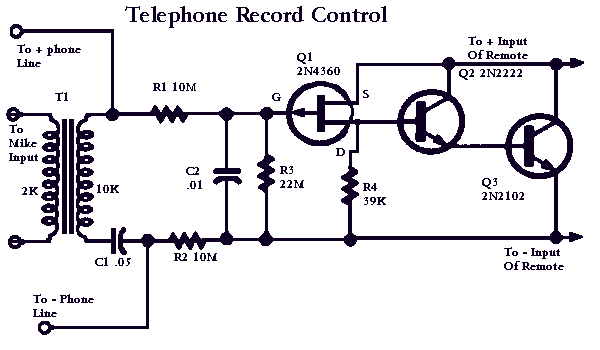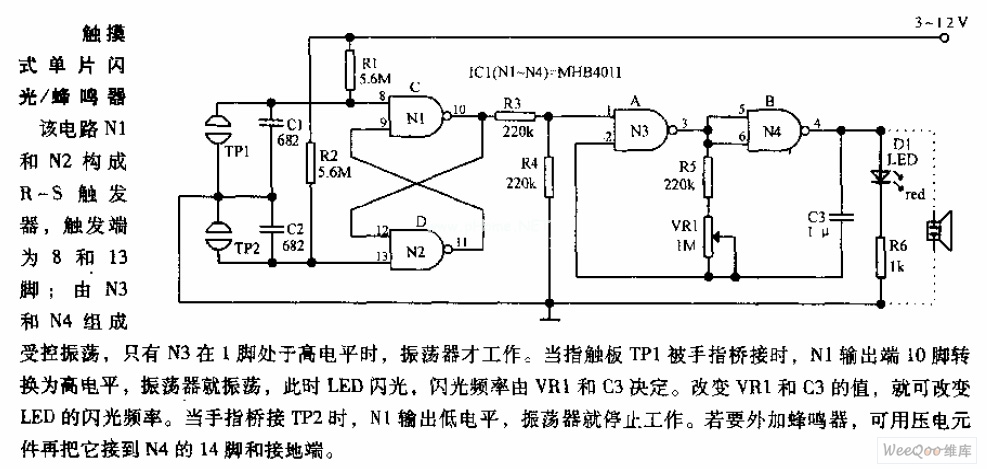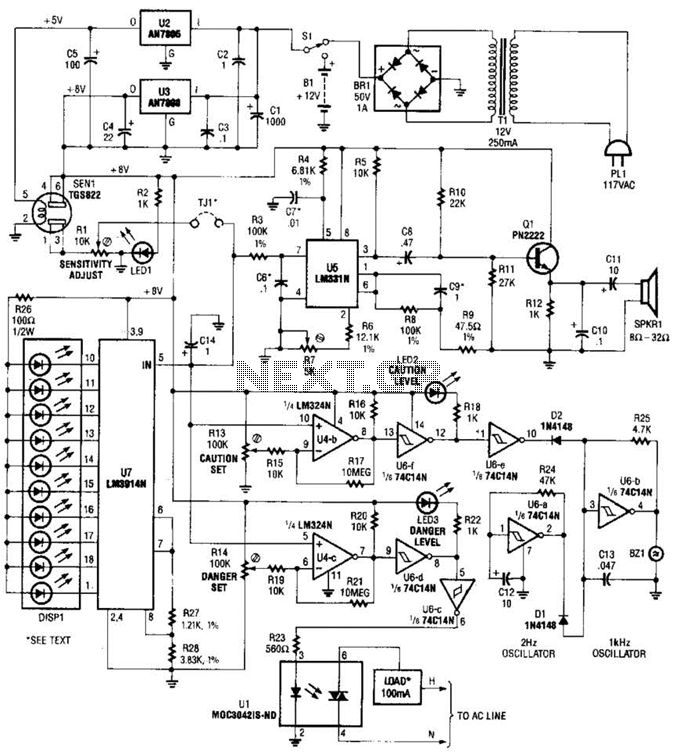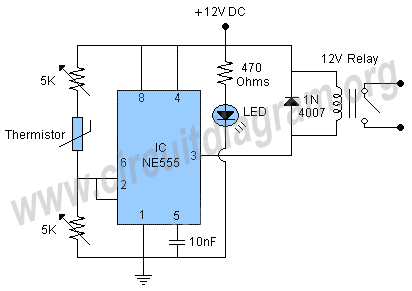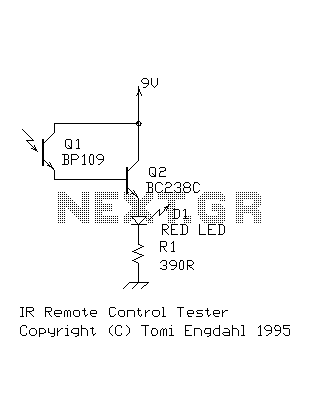
Small class b audio amplifier circuit diagram
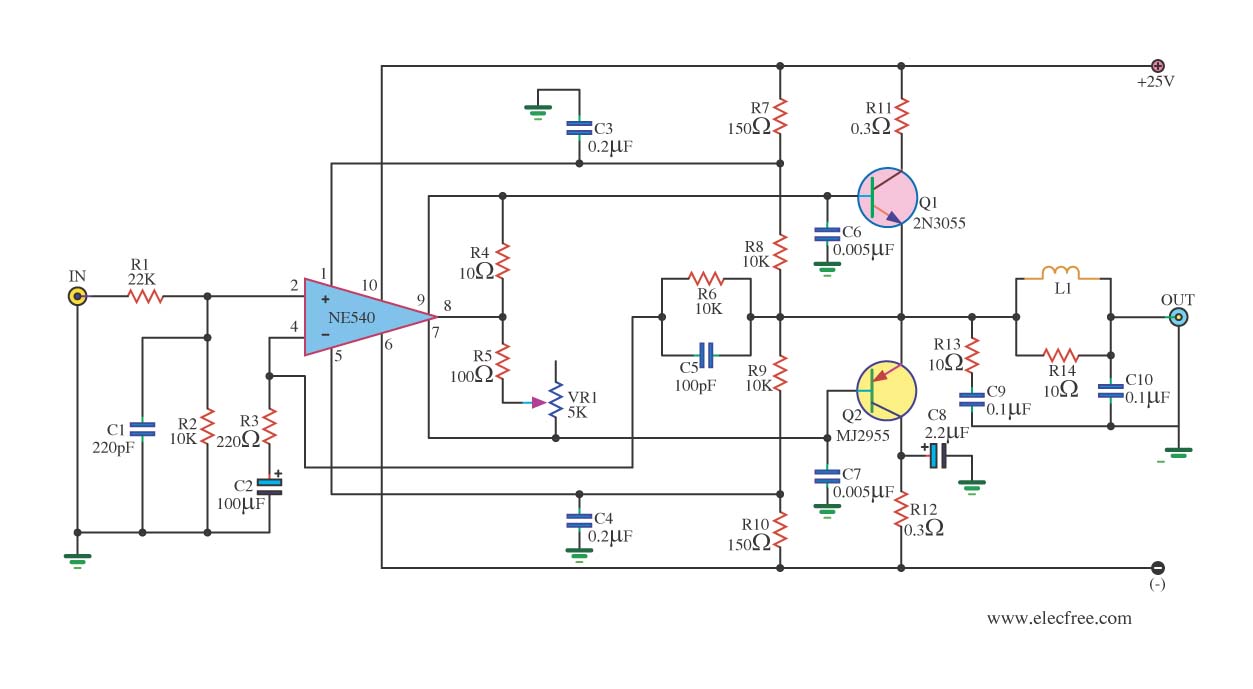
When the power supply reaches the circuit and the input signal is applied, the sound signal is processed through capacitor C1 and resistor R1 for signal coupling and noise reduction. The modified signal then reaches pin 3 (non-inverting) of operational amplifier IC1, which amplifies the signal, increasing its power to drive transistors Q1 and Q2. IC1 has an expansion rate of 15 times, calculated from (R3/R2)+1. The amplified signal exits pin 1 of IC1 to drive Q1 and Q2, which are configured in a push-pull arrangement to handle both positive and negative signal sections. Q2 amplifies the positive section of the signal and feeds it to output transistor Q3, while Q1 boosts the negative section and drives output transistor Q4. Q1 and Q4 are also configured in a Darlington pair, enhancing the output signal of Q4 and Q3. The combined output signals from Q4 and Q3 are sent to the loudspeaker. To manage the heat generated by Q3 and Q4 during operation, appropriate heat dissipation measures are implemented. The circuit described is based on an older electronics kit, specifically a Power Amplifier OCL 25W using IC STK032, which lacks a schematic. The circuit incorporates controls for volume, bass, and treble, and is designed as an OCL Class AB integrated amplifier capable of delivering 25W with good sound quality. Additionally, another version of the OCL circuit is presented, rated at approximately 35W for 8-ohm loudspeakers, utilizing a power supply of +25V and -25V at 2A. This circuit features the NE540 integrated circuit, replacing traditional transistors, and employs power transistors 2N3055 and MJ2955 at the output stage.
The circuit operates on a dual power supply, providing both positive and negative voltages to accommodate the Class AB amplification, which is essential for minimizing distortion and achieving high fidelity in audio applications. The use of an operational amplifier (IC1) ensures that the input audio signal is accurately amplified while maintaining signal integrity. The selection of components, including capacitors and resistors, is critical for setting the gain and frequency response of the amplifier. Capacitor C1 serves to block any DC offset from the input signal, allowing only the AC audio signal to pass through to the amplifier stage.
The push-pull configuration of Q1 and Q2 allows for efficient amplification of both halves of the audio waveform, which is crucial for producing a clean and powerful output. The Darlington pairs formed by Q1 with Q4 and Q2 with Q3 increase the current gain, allowing the circuit to drive heavier loads such as loudspeakers without significant distortion. The thermal management of the output transistors is vital, as excessive heat can lead to thermal runaway and potential failure of the transistors. Heat sinks or other cooling methods should be employed to ensure reliable operation.
This design is particularly advantageous for beginners in electronics, as it provides a straightforward approach to building a functional audio amplifier while allowing for further modifications and enhancements. The inclusion of tone controls (volume, bass, and treble) adds versatility to the amplifier, enabling users to tailor the audio output to their preferences. Overall, this OCL Class AB amplifier circuit exemplifies a practical application of fundamental electronic principles in audio engineering.When feed power supply reach the circuit and feed input signal come in. The sound signal change C1 and R1 for signal coupling and eradicate noise oscillator go out. From that time go to reach input pin 3 non inverting of IC1. Which be op-amp IC boost up signal give the power goes up in order to go to drive give Q1 and Q2 work. Which IC1 will haveexpansion rate at 15 times can calculate from (R3/R2)+1. From that time signal that enlarge already go out pin 1 of IC1 go to feed give with Q1 and Q2 which build the circuit model put-pull do signal both of section expansion positive and the section negative. By Q2 enlarge signal section way positive and build output give with Q3 which Q2 and Q3 this each other darlington for have the expansion ratio more and more.
Part Q1 signal boost up section way negative and build output signal give Q4. Which Q1 and Q4 build the circuit model Darlington also output signal of Q4 and Q3 and go out pin way E come to total up signal section positive and the section negative already go out still a loudspeaker. Because of while the circuit will work to is born the heat Q3 and Q4 thus then must add let off the heat gives with Q3 and Q4 with.
A younger brother of me receives Electronics KIT that older. It is Power Amp OCL 25w With IC STK032. But have no the circuit. I has looked into already be model to follow the circuit. When see already a button fines to decorate Volume, Bass and Treble of the sound has completely. And still the circuit integrated amplifier model OCL Class AB as well although will have 25Watt drives. But have a voice good loud moderately completed convenient for a novice, build good easy please sir. Today have Older power Amplifier OCL Circuit come to give friends get see in rows the way again. By it has the electric power about 35W at 8ohm loudspeakers and use Voltage Supply +25V and -25V at Current 2A.
Which cheap systematize the sound is Class AB. By this circuit use the integrated circuit number NE540 replace the transistor has many. Then use power Transistor 2N3055 and MJ2955 at output. The detail is other invite a friend has seen in the circuit, be lucky sir. 🔗 External reference
The circuit operates on a dual power supply, providing both positive and negative voltages to accommodate the Class AB amplification, which is essential for minimizing distortion and achieving high fidelity in audio applications. The use of an operational amplifier (IC1) ensures that the input audio signal is accurately amplified while maintaining signal integrity. The selection of components, including capacitors and resistors, is critical for setting the gain and frequency response of the amplifier. Capacitor C1 serves to block any DC offset from the input signal, allowing only the AC audio signal to pass through to the amplifier stage.
The push-pull configuration of Q1 and Q2 allows for efficient amplification of both halves of the audio waveform, which is crucial for producing a clean and powerful output. The Darlington pairs formed by Q1 with Q4 and Q2 with Q3 increase the current gain, allowing the circuit to drive heavier loads such as loudspeakers without significant distortion. The thermal management of the output transistors is vital, as excessive heat can lead to thermal runaway and potential failure of the transistors. Heat sinks or other cooling methods should be employed to ensure reliable operation.
This design is particularly advantageous for beginners in electronics, as it provides a straightforward approach to building a functional audio amplifier while allowing for further modifications and enhancements. The inclusion of tone controls (volume, bass, and treble) adds versatility to the amplifier, enabling users to tailor the audio output to their preferences. Overall, this OCL Class AB amplifier circuit exemplifies a practical application of fundamental electronic principles in audio engineering.When feed power supply reach the circuit and feed input signal come in. The sound signal change C1 and R1 for signal coupling and eradicate noise oscillator go out. From that time go to reach input pin 3 non inverting of IC1. Which be op-amp IC boost up signal give the power goes up in order to go to drive give Q1 and Q2 work. Which IC1 will haveexpansion rate at 15 times can calculate from (R3/R2)+1. From that time signal that enlarge already go out pin 1 of IC1 go to feed give with Q1 and Q2 which build the circuit model put-pull do signal both of section expansion positive and the section negative. By Q2 enlarge signal section way positive and build output give with Q3 which Q2 and Q3 this each other darlington for have the expansion ratio more and more.
Part Q1 signal boost up section way negative and build output signal give Q4. Which Q1 and Q4 build the circuit model Darlington also output signal of Q4 and Q3 and go out pin way E come to total up signal section positive and the section negative already go out still a loudspeaker. Because of while the circuit will work to is born the heat Q3 and Q4 thus then must add let off the heat gives with Q3 and Q4 with.
A younger brother of me receives Electronics KIT that older. It is Power Amp OCL 25w With IC STK032. But have no the circuit. I has looked into already be model to follow the circuit. When see already a button fines to decorate Volume, Bass and Treble of the sound has completely. And still the circuit integrated amplifier model OCL Class AB as well although will have 25Watt drives. But have a voice good loud moderately completed convenient for a novice, build good easy please sir. Today have Older power Amplifier OCL Circuit come to give friends get see in rows the way again. By it has the electric power about 35W at 8ohm loudspeakers and use Voltage Supply +25V and -25V at Current 2A.
Which cheap systematize the sound is Class AB. By this circuit use the integrated circuit number NE540 replace the transistor has many. Then use power Transistor 2N3055 and MJ2955 at output. The detail is other invite a friend has seen in the circuit, be lucky sir. 🔗 External reference
